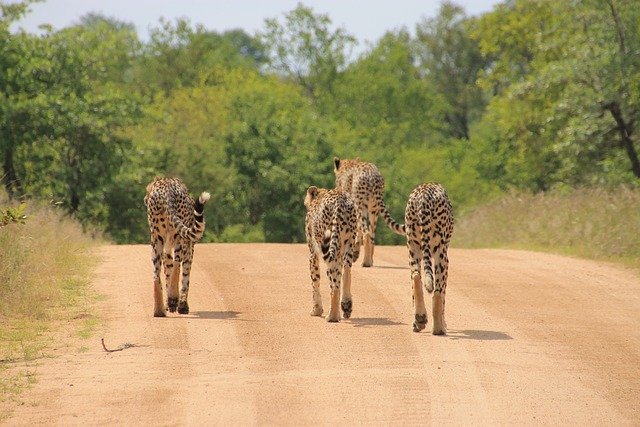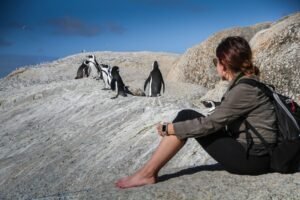
In this article, we will show you how to create a South Africa 10 day itinerary that covers the best places to visit, the best time to go, the best ways to get around, and the best things to do. We will also give you some tips on how to save money, stay safe, and have fun in South Africa.
South Africa is a diverse and captivating destination that offers something for every traveler. Whether you want to explore the stunning landscapes, experience the rich culture, enjoy the wildlife, or relax on the beaches, South Africa has it all. But how do you plan the perfect trip to this amazing country?
Key Takeaways
- South Africa is a large and diverse country with different climates, cultures, and attractions. You can’t see everything in 10 days, so you need to prioritize your interests and choose your destinations accordingly.
- The best time to visit South Africa depends on what you want to see and do. Generally, the dry season (May to September) is good for wildlife viewing and hiking, while the wet season (October to April) is good for flowers and beaches.
- The best way to get around South Africa is by renting a car or joining a tour. Public transportation is limited and unreliable, especially in rural areas. Driving in South Africa is easy and safe, as long as you follow the rules and stay alert.
- The best things to do in South Africa include visiting Cape Town and its surroundings, exploring the Garden Route and its scenic towns, experiencing the wildlife and nature of Kruger National Park and other reserves, and enjoying the culture and history of Johannesburg and Pretoria.
- The best way to save money in South Africa is by traveling off-season, booking in advance, staying in budget accommodation, eating local food, and using discounts and coupons.
- The best way to stay safe in South Africa is by avoiding crime-prone areas, especially at night, keeping your valuables secure, being aware of your surroundings, following local advice, and having travel insurance.
Estimated Costs of Transportation, Accommodation, Food, and Activities
| Item | Average Cost per Day (USD) |
|---|---|
| Transportation (car rental + gas) | $40 |
| Accommodation (mid-range hotel or guesthouse) | $60 |
| Food (breakfast + lunch + dinner + snacks) | $30 |
| Activities (entrance fees + tours + tips) | $50 |
| Total | $180 |
Note: These are approximate costs based on average prices as of 2023. They may vary depending on the season, location, availability, and personal preferences.
Statistics about the last five years Travellers Incoming with Pictures
According to the Tourism 2020 report released by Statistics South Africa, the number of international tourists arriving in South Africa has fluctuated over the last five years. The peak was in 2019 with over 10 million arrivals, while the lowest was in 2020 with less than 3 million arrivals due to the COVID-19 pandemic. The main source markets for tourists were from other African countries (74%), followed by Europe (15%), Asia (4%), North America (3%), Australasia (2%), and Middle East (1%). The most visited provinces were Gauteng (28%), Western Cape (23%), KwaZulu-Natal (14%), Mpumalanga (11%), and Limpopo (9%).
Source: Statistics South Africa
South Africa 10 Day Itinerary: Day by Day Breakdown
Here is a sample itinerary for 10 days in South Africa that covers some of the most popular destinations and activities. You can modify it according to your preferences and budget.
Day 1: Arrive in Cape Town
Cape Town is one of the most beautiful and vibrant cities in the world. It is surrounded by stunning natural scenery, such as Table Mountain, Lion’s Head, Signal Hill, and the Atlantic Ocean. It also has a rich cultural heritage, with influences from various ethnic groups, such as Malay, Dutch, British, French, German, Indian, and African.
After arriving at Cape Town International Airport (CPT), you can take a taxi or an Uber to your hotel or guesthouse. Depending on your arrival time, you can spend the rest of the day exploring some of the city’s attractions.
Some of the highlights include:
- Taking a cable car or hiking up to Table Mountain for panoramic views of the city and the ocean.
- Visiting Robben Island , where Nelson Mandela was imprisoned for 18 years during apartheid.
- Exploring the colorful Bo-Kaap neighborhood, where the Malay community lives and works.
- Strolling along the Victoria & Alfred Waterfront , where you can find shops, restaurants, bars, museums, and entertainment.
- Watching the sunset from Camps Bay or Clifton Beach , two of the most popular and scenic beaches in Cape Town.
Day 2: Cape Peninsula Tour
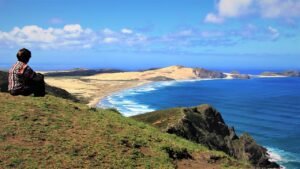
On your second day, you can join a full-day tour of the Cape Peninsula , which is a spectacular stretch of coastline that forms the southwestern tip of Africa.
You can book a tour online or through your hotel or guesthouse. Alternatively, you can rent a car and drive yourself, following the scenic route along the Atlantic Seaboard.
Some of the highlights include:
- Driving along Chapman’s Peak Drive , one of the most scenic roads in the world, with views of the ocean and the mountains.
- Visiting Cape Point , where you can see the lighthouse, the old naval station, and the meeting point of the Indian and Atlantic Oceans.
- Exploring Cape of Good Hope Nature Reserve , where you can spot wildlife such as baboons, ostriches, antelopes, and zebras.
- Stopping at Boulders Beach , where you can see a colony of endangered African penguins and swim with them if you wish.
- Visiting Simon’s Town , a historic naval town with a charming waterfront and a museum.
- Returning to Cape Town via Muizenberg , a surfing hotspot with colorful beach huts and a shark spotters program.
Day 3: Winelands Tour

On your third day, you can join a full-day tour of the Winelands , which are the wine-producing regions around Cape Town.
You can book a tour online or through your hotel or guesthouse. Alternatively, you can rent a car and drive yourself, following the wine routes that connect the different towns and estates.
Some of the highlights include:
- Visiting Stellenbosch , the second oldest town in South Africa and the heart of the wine industry. You can admire the Cape Dutch architecture, visit the university campus, and taste some of the best wines in the country.
- Visiting Franschhoek , a picturesque town with a French heritage and a culinary reputation. You can enjoy the views of the mountains, visit the Huguenot Memorial Museum, and sample some of the local delicacies.
- Visiting Paarl , a town with a rich history and culture. You can see the Afrikaans Language Monument, visit the Taal Museum, and taste some of the award-winning wines.
- Visiting other smaller towns and estates along the way, such as Wellington, Tulbagh, Robertson, Montagu, and Worcester. You can learn about the history, culture, and production of wine in South Africa, and taste different varieties and styles.
Day 4: Fly to Johannesburg
On your fourth day, you can fly from Cape Town to Johannesburg , the largest and most populous city in South Africa. It is also known as the City of Gold, because of its role in the gold mining industry. It is a vibrant and dynamic city that offers a contrast to Cape Town’s laid-back charm.
After arriving at O.R. Tambo International Airport (JNB), you can take a taxi or an Uber to your hotel or guesthouse. Depending on your arrival time, you can spend the rest of the day exploring some of the city’s attractions.
Some of the highlights include:
- Visiting Soweto , a township that was once home to Nelson Mandela and Desmond Tutu. You can see their former houses, visit the Hector Pieterson Museum, and learn about the history and culture of Soweto.
- Visiting Apartheid Museum , which tells the story of South Africa’s struggle against racial segregation and oppression. You can see exhibits, artifacts, photos, videos, and testimonies that depict the harsh realities of apartheid.
- Visiting Constitution Hill , which is a former prison complex that now houses the Constitutional Court. You can see the cells where political prisoners were held, visit the Women’s Jail Museum, and learn about South Africa’s transition to democracy.
- Visiting Gold Reef City , which is an amusement park that recreates Johannesburg’s gold mining heyday. You can ride roller coasters, watch shows, play games, and even go underground to see how gold was mined.
Day 5: Pretoria Tour
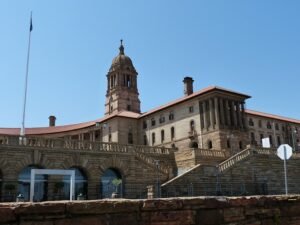
On your fifth day, you can join a half-day tour of Pretoria , which is South Africa’s administrative capital and one of its oldest cities.
You can book a tour online or through your hotel or guesthouse. Alternatively, you can rent a car and drive yourself, following the signs to Pretoria.
Some of the highlights include:
- Visiting Voortrekker Monument , which is a massive granite structure that commemorates the pioneers who migrated from Cape Colony to escape British rule. You can see sculptures, murals, relics, and exhibits that depict their history and culture.
-
- Visiting Union Buildings, which are the official seat of the South African government and the president. You can see the impressive architecture, the gardens, the statues, and the panoramic views of the city.
- Visiting Church Square, which is the historic center of Pretoria and the site of many important events. You can see the old buildings, the monuments, the fountain, and the market.
- Visiting Kruger House Museum, which is the former residence of Paul Kruger, the president of the Transvaal Republic. You can see his personal belongings, his carriage, his memorabilia, and his tomb.
Day 6: Fly to Kruger National Park
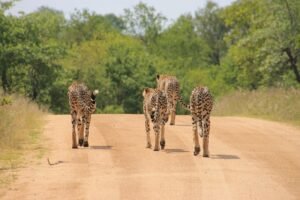
On your sixth day, you can fly from Johannesburg to Kruger National Park, which is one of the largest and most famous wildlife reserves in Africa.
It covers an area of over 19,000 square kilometers and hosts a variety of animals, birds, plants, and ecosystems. It is also home to the Big Five: lion, leopard, elephant, rhino, and buffalo.
After arriving at one of the airports near Kruger National Park (such as Skukuza (SZK), Hoedspruit (HDS), or Nelspruit (MQP)), you can take a shuttle or a taxi to your lodge or campsite. Depending on your arrival time, you can spend the rest of the day relaxing or joining a game drive.
Some of the highlights include:
- Staying in a comfortable lodge or a rustic campsite that offers amenities such as swimming pools, restaurants, bars, shops, and Wi-Fi.
- Joining a game drive with a professional guide who will take you to the best spots to see wildlife. You can choose from different options such as morning, afternoon, evening, or full-day drives.
- Seeing a variety of animals such as lions, leopards, elephants, rhinos, buffaloes, giraffes, zebras, wildebeests, antelopes, hyenas, jackals, cheetahs, wild dogs, hippos, crocodiles, and more.
- Spotting different birds such as eagles, vultures, owls, hornbills, kingfishers, bee-eaters, rollers, weavers, sunbirds, and more.
- Enjoying the scenery of different landscapes such as savanna, woodland, riverine forest, mountain range, and wetland.
Day 7: Kruger National Park
On your seventh day, you can continue to explore Kruger National Park and its amazing wildlife. You can join another game drive or try some other activities that are available in the park.
Some of the highlights include:
- Joining a walking safari with an armed ranger who will take you closer to nature and teach you about tracking skills and bush survival techniques.
- Joining a bush breakfast or dinner where you can enjoy a delicious meal in the middle of the wilderness while watching animals and birds.
- Joining a night drive where you can see nocturnal animals such as leopards, hyenas, owls, porcupines, civets, and more.
- Visiting some of the camps, rest stops, and picnic sites where you can find facilities such as museums, shops, restaurants, and viewpoints.
- Visiting some of the historical and cultural sites such as Albasini Ruins, Masorini Village, Thulamela, and Bushman Rock Art.
- Exploring some of the scenic routes and loops that offer different perspectives and experiences of the park.
Day 8: Fly to Port Elizabeth

On your eighth day, you can fly from Kruger National Park to Port Elizabeth , which is a coastal city in the Eastern Cape province.
It is also known as the Friendly City or the Windy City, because of its warm hospitality and breezy weather. It is a gateway to the Garden Route , which is a scenic route that stretches along the southern coast of South Africa.
After arriving at Port Elizabeth International Airport (PLZ), you can take a taxi or an Uber to your hotel or guesthouse. Depending on your arrival time, you can spend the rest of the day exploring some of the city’s attractions.
Some of the highlights include:
- Visiting Donkin Reserve , which is a public park that features a lighthouse, a pyramid, a statue, and a mosaic.
- Visiting Nelson Mandela Metropolitan Art Museum , which showcases a collection of South African and international art.
- Visiting Addo Elephant National Park , which is home to over 600 elephants and other animals such as lions, buffaloes, rhinos, zebras, and antelopes.
- Visiting Kragga Kamma Game Park , which is a private reserve that offers close encounters with cheetahs, giraffes, rhinos, and other animals.
- Visiting SAMREC , which is a marine bird rehabilitation center that cares for injured penguins and other seabirds.
Day 9: Garden Route Tour
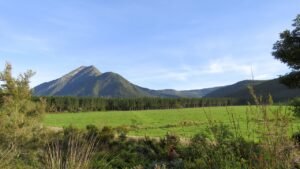
On your ninth day, you can join a full-day tour of the Garden Route , which is one of the most beautiful and diverse regions in South Africa.
You can book a tour online or through your hotel or guesthouse. Alternatively, you can rent a car and drive yourself, following the N2 highway that connects Port Elizabeth to Cape Town.
Some of the highlights include:
- Visiting Tsitsikamma National Park , which is a coastal reserve that offers activities such as hiking, kayaking, zip-lining, bungee jumping, and bridge walking.
- Visiting Plettenberg Bay , which is a seaside town that offers beaches, lagoons, forests, and wildlife sanctuaries.
- Visiting Knysna , which is a town that lies on the banks of a large lagoon that is surrounded by forests and mountains. You can enjoy activities such as boating, fishing, golfing, and shopping.
- Visiting Oudtshoorn , which is a town that is known as the ostrich capital of the world. You can visit an ostrich farm, ride an ostrich, feed an ostrich, or buy ostrich products.
- Visiting Cango Caves , which are ancient limestone caves that feature stalactites, stalagmites, chambers, and formations.
Day 10: Fly back to Cape Town
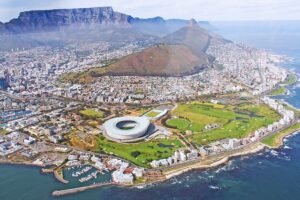
On your tenth and final day, you can fly back to Cape Town from one of the airports along the Garden Route (such as George (GRJ), Mossel Bay (MZY), or Plettenberg Bay (PBZ)).
You can spend some time in Cape Town before catching your flight home or to your next destination.
Some of the things you can do in Cape Town include:
- Shopping for souvenirs at Greenmarket Square , Long Street , or V&A Waterfront .
- Eating some of the local specialties such as bobotie , bunny chow , biltong , malva pudding , or rooibos tea .
- Relaxing at one of the many spas or wellness centers in Cape Town.
- Taking some photos at one of the many Instagram-worthy spots in Cape Town.
Pre-Trip Checklist
Before you embark on your South Africa 10 day itinerary, here are some things you need to prepare and pack:
Item Description Passport You need a valid passport that has at least two blank pages and expires at least six months after your date of departure. Visa You may need a visa depending on your nationality and purpose of visit. You can check the visa requirements [here]. Flight tickets You need to book your flight tickets in advance to get the best deals and availability. You can compare prices and options [here]. Accommodation You need to book your accommodation in advance to get the best deals and availability. You can compare prices and options [here]. Transportation You need to book your transportation in advance to get the best deals and availability. You can compare prices and options for car rental [here], for bus [here], and for train [here]. Travel insurance You need to have travel insurance that covers medical expenses, emergency evacuation, theft, loss, and cancellation. You can compare prices and options [here]. Vaccinations You may need some vaccinations depending on your health status and travel history. You can check the recommended vaccinations [here]. Malaria prophylaxis You may need to take malaria prophylaxis if you are visiting malaria-risk areas such as Kruger National Park. You can check the malaria map [here] and consult your doctor for advice. Packing list You need to pack according to the season, the climate, and the activities you plan to do. Here is a suggested packing list for all seasons: Clothing (All Seasons) Additional Misc. Items Hiking Items and Gear Lightweight shirts and pants Sunscreen Hiking boots or shoes Warm sweater or jacket Sunglasses Hiking socks Raincoat or umbrella Hat or cap Hiking pants or shorts Swimwear Insect repellent Hiking shirt Underwear and socks Water bottle Backpack Sleepwear Camera and charger Trekking poles Comfortable shoes or sandals Phone and charger First aid kit Scarf or shawl Adapter and converter Flashlight or headlamp FAQs
Here are some frequently asked questions about traveling to South Africa:
- What is the best time to visit South Africa?
The best time to visit South Africa depends on what you want to see and do. Generally, the dry season (May to September) is good for wildlife viewing and hiking, while the wet season (October to April) is good for flowers and beaches. However, South Africa has different climates in different regions, so you need to check the weather forecast before you go.
- How do I get around in South Africa?
The best way to get around in South Africa is by renting a car or joining a tour. Public transportation is limited and unreliable, especially in rural areas. Driving in South Africa is easy and safe, as long as you follow the rules and stay alert. You can also use taxis or Ubers in urban areas, but they can be expensive and scarce.
- What are some other destinations in South Africa?
South Africa has many other destinations that are worth visiting, such as:
- Durban is a coastal city with a subtropical climate, a vibrant culture, and a golden beachfront.
- The Drakensberg is a mountain range that offers stunning scenery, hiking trails, rock art, and wildlife.
- Kimberley is a historic town that was the center of the diamond rush in the 19th century. You can see the Big Hole, the Diamond Museum, and the Ghost Town.
- Hermanus is a seaside town that is famous for whale watching, wine tasting, and adventure activities.
- Kruger National Park is one of the largest and most famous wildlife reserves in Africa.
- How do I book tours and activities in South Africa?
You can book tours and activities in South Africa online or through your hotel or guesthouse. You can compare prices and options [here]. You can also find local guides and operators on sites such as [TripAdvisor] or [Airbnb Experiences].
- What are some other popular beaches in South Africa?
South Africa has many other popular beaches that are worth visiting, such as:
- Bloubergstrand, which is a beach near Cape Town that offers views of Table Mountain and Robben Island.
- Jeffreys Bay is a beach near Port Elizabeth that is famous for surfing, fishing, and shell collecting.
- Umhlanga Rocks, which is a beach near Durban that offers luxury resorts, restaurants, bars, and entertainment.
- Wilderness, which is a beach along the Garden Route that offers tranquility, nature, and adventure.
- Muizenberg is a beach near Cape Town that is popular for surfing, swimming, and shark spotting.
- What is some good tour operator for South Africa?
Some of the good tour operators for South Africa are:
- Intrepid Travel, offers small group tours that focus on local experiences, culture, and sustainability.
- G Adventures, which offers small group tours that focus on adventure, community, and fun.
- African Budget Safaris, offers budget-friendly tours that focus on wildlife, nature, and camping.
- Hotspots2c, which offers customized tours that focus on your preferences, budget, and style.
Conclusion
South Africa is a wonderful destination that offers a variety of experiences, attractions, and activities for every traveler. You can enjoy the beauty, culture, wildlife, and adventure of this diverse and captivating country.
With this South Africa 10 day itinerary, you can plan the perfect trip that covers the best places to visit, the best time to go, the best ways to get around, and the best things to do. We hope you have a great time in South Africa and come back with unforgettable memories.

